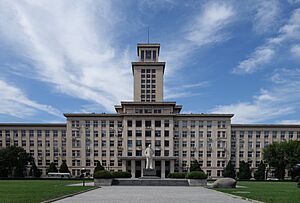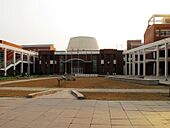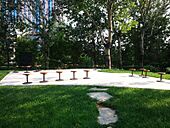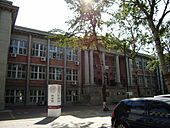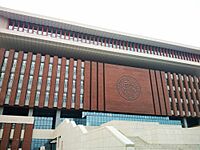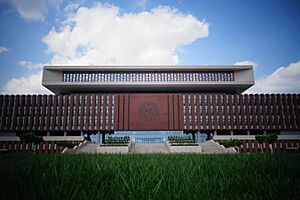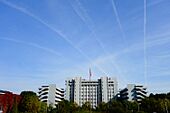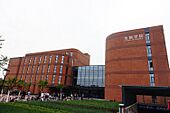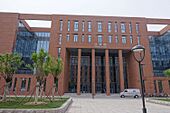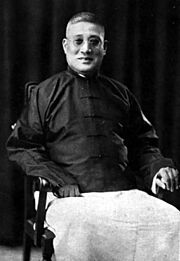Nankai University facts for kids
|
南开大学
|
|
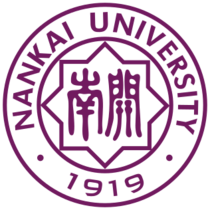 |
|
| Motto | 允公允能,日新月异 |
|---|---|
|
Motto in English
|
Dedication to Public Interests, Acquisition of All-round Capability, Aspiration for Progress with Each Passing Day |
| Type | National, Public |
| Established | 1919 |
| President | Chen Yulu |
|
Academic staff
|
2,286 |
| Undergraduates | 17,339 |
| Postgraduates | 17,467 |
| Location |
,
China
|
| Campus | Balitai, Jinnan, TEDA |
| Website | nankai.edu.cn |
| Nankai University | |||||||||
|---|---|---|---|---|---|---|---|---|---|
| Simplified Chinese | 南开大学 | ||||||||
| Traditional Chinese | 南開大學 | ||||||||
|
|||||||||
Nankai University is a well-known public university in Tianjin, China. It works closely with the Ministry of Education of China. Nankai is part of important national plans like Project 211, Project 985, and the Double First-Class Construction. These plans help make it one of China's best universities.
The university started in 1919. It was founded as a private school by Yan Xiu and Zhang Boling. During the Second Sino-Japanese War (1937-1945), Nankai University joined with Peking University and Tsinghua University. They formed the National Changsha Provisional University. This university later moved to Kunming and was renamed the National Southwestern Associated University. In 2000, the Ministry of Education and Tianjin City agreed to work together to develop Nankai University.
Many famous people have studied at Nankai. This includes Zhou Enlai, who was the first Premier of the People's Republic of China. Also, the famous mathematician Shiing-Shen Chern and Nobel Prize winners Chen Ning Yang and Tsung-Dao Lee are Nankai alumni.
Contents
Exploring Nankai University's Past
Early Years: 1919–1937
Nankai University began as a private school in 1919. It was quite small at first. It had only three departments: liberal arts, science, and business. There were 96 students. The university did not get money from the government. Instead, it was supported by foreign charities and local business people. Nankai was known for teaching courses in English. It used foreign textbooks and learning plans.
The famous Nankai Institute of Economics started in 1927. It quickly became very important in China. It was the first Chinese group to figure out a Consumer Price Index for the country.
By 1937, Nankai had grown a lot. It had three colleges, 13 departments, and two research centers. There were 429 students and 110 teachers and staff. People sometimes called it "The North Star of Higher Learning."
Wartime Challenges: 1937–1949
In July 1937, during the Sino-Japanese War, Nankai's campus was badly damaged. Japanese bombings destroyed about two-thirds of its buildings, including the library. Some of the school's important items, like the university bell, were taken. They are still in Japanese museums today.
In August 1937, Nankai University, Peking University, and Tsinghua University joined together. They formed the National Changsha Provisional University. This group later moved to Kunming and was renamed the National Southwestern Associated University. After the war ended in 1946, Nankai returned to Tianjin. The government then made it a national university. At that time, Nankai had four schools and 16 departments.
Growth and Change: 1949–Present
After the People's Republic of China was founded, Nankai changed its focus. It became a university that taught many subjects, especially arts and sciences. It had 14 departments and three special programs.
From 1966 to 1976, the university's normal activities were disrupted. This was due to a period known as the Cultural Revolution. In 1976, a large earthquake happened near Tianjin. This earthquake caused damage to many of the school's buildings.
In February 1978, Nankai University was chosen as a top national university again. After 1980, Nankai added many new subjects and research centers. It started new programs in finance and reopened the School of Economics. In sciences, it added new subjects that combined different fields. It also focused on new technologies.
By the late 1980s, Nankai University had become a full university. It covered subjects like Humanities, Natural Sciences, Applied Sciences, Life Sciences, Management, and Art.
In 1994, Tianjin Foreign Trade College joined Nankai University. In 1999, Nankai and TEDA worked together to create TEDA College. In 2000, the Ministry of Education and Tianjin City agreed to jointly develop Nankai University. Nankai also started working with Tianjin University. In 2002, Nankai, the government of Shenzhen, and UC Berkeley created the Financial Engineering College in Shenzhen.
In 2006, Nankai's president worked to improve the university's programs. He changed leaders in many of the university's colleges.
In 2015, Nankai's president, Gong Ke, spoke out about academic freedom. He said that universities should not repeat past mistakes of limiting ideas.
-
Cemetery of Shiing-shen Chern
Nankai University Campuses
Nankai University has three main campuses. These are Balitai, Jinnan, and TEDA. The total area of the campuses is about 456 hectares. The buildings cover about 137 hectares.
Balitai Campus
Balitai was the very first campus of Nankai. It opened in 1919 and is in the Nankai district of Tianjin. This campus is home to 10 colleges. These include the Business School, School of Economics, School of Literature, and College of Chemistry.
Jinnan Campus
Jinnan campus is the newest campus for Nankai University. It opened in September 2015. This campus is located in the Jinnan Area. It hosts 14 colleges. Some of these are the Zhou Enlai School of Government, School of Medicine, Law School, and College of Computer and Control Engineering.
TEDA Campus
The TEDA campus is in the Binhai New Area. It houses the TEDA Institute of Biological Sciences and Biotechnology. It also has the TEDA Institute of Applied Physics.
Learning and Research at Nankai
Nankai is a university that teaches many different subjects. It is overseen by the Ministry of Education.
Teaching and Learning Programs
The university offers programs in many areas. These include humanities, natural sciences, technology, life sciences, medical sciences, and the arts. It has a good balance between science and liberal arts subjects.
Nankai's school year has two terms. The first term starts in early September and ends in early January. The second term begins in early February and finishes in early July. There is a winter break in January and a summer break from July to September.
In 2013, Nankai had 22 colleges and schools. It offered 79 bachelor's degree programs, 231 master's degree programs, and 172 PhD programs. About 12,000 undergraduate students and 11,000 graduate students were enrolled. Around 10% of the students were international students from different countries.
By 2018, the university offered 80 undergraduate programs. It also had 231 Master's and 172 PhD programs. There were 28 post-doctoral research stations. The total number of full-time students was 24,525. The teaching staff included 1,986 full-time teachers.
Nankai offers various scholarships to help students. These include the Chinese Government Scholarship for international students. There are also scholarships from the Tianjin Government and Nankai University itself.
Nankai also has many programs for international exchange. It works with over 300 universities and schools around the world. For example, it has an Elementary School Chinese Program with schools in the US. In 2010, the "Study International" program started. It aimed to send many American students to China, and Nankai was one of the first universities to host them.
In 2012, Nankai was invited to join The Global University Leaders Forum (GULF). This is a group of top universities worldwide, like Yale University, Harvard University, and the University of Oxford.
Research and Global Connections
Nankai University has many international partnerships for research. It works with over 200 universities and research groups. Several Nobel Prize winners have been made Honorary Professors at Nankai. These include Chen Ning Yang, Tsung-Dao Lee, and Robert A. Mundell. Important leaders like former President of Korea Kim Dae Jung and former US Secretary of State Henry Kissinger have also received this honor.
In 2016, Robert F. Engle, a Nobel Prize winner in economics, became an honorary professor at Nankai. Many other famous scholars and business leaders have visited Nankai as professors.
Nankai is especially known for its mathematics programs. It has become one of the most famous centers for mathematics globally. Shiing-Shen Chern established a very large mathematics institute at Nankai.
Nankai has also set up nine Confucius Institutes around the world. Scientists from Nankai have contributed to many important scientific discoveries and advancements.
Nankai University's Reputation
| BCUR National | Domestic | 21 | |
|---|---|---|---|
| Wu Shulian National | Domestic | 24 | |
| CUAA National | Alumni | 9 | |
| QS National | General | 20 | |
| THE National | General | 17–20 | |
| QS Asia (Asia version) |
General | 92 | |
| THE Asia (Asia version) |
General | 55 | |
| ARWU World | Research | 151–200 | |
| QS World | General | =377 | |
| THE World | General | 251–300 | |
| USNWR World | General | =256 | |
Nankai University is often ranked among the top 10 universities in China. For example, in 2011, it was ranked 10th by Renmin University of China and by Netbig ranking. In the 2013 QS World University Rankings, it was 62nd among Asian universities and 11th in China. In 2013, the CWTS Leiden Ranking placed it 53rd among world universities and 1st in China. In the Nature Index Global 2014, it was 83rd worldwide and 7th in China.
Top Programs at Nankai
The university is also highly respected for its excellent undergraduate programs. Nankai's programs in mathematics, chemistry, history, business, and economics are considered some of the best in China.
Student Life at Nankai
Student Community
In 2018, Nankai had 24,525 full-time students. This included 13,067 undergraduate students, 8,162 postgraduate students, and 3,296 PhD students. Among them, 1,902 were international students.
Colleges and Schools at Nankai
|
|
Important People from Nankai
University Presidents
- Zhang Boling (张伯苓): 1919–1948
- He Lian (何廉): 1948–1957 (acting)
- Yang Shixian (杨石先): 1957–1969
- No president during a difficult period: 1969–1978
- Zang Boping (臧伯平): 1978
- Yang Shixian (second time): 1979–1981
- Teng Weizao (滕维藻): 1981–1986
- Mu Guoguang (母国光): 1986–1995
- Hou Zixin (侯自新): 1995–2006
- Rao Zihe (饶子和): 2006–2011
- Gong Ke (龚克): 2011–2018
- Cao Xuetao (曹雪涛): 2018–2022
- Chen Yulu (陈雨露): 2022–present
Famous Alumni
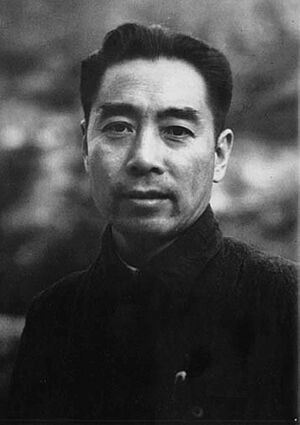
Many notable people have graduated from Nankai University, including:
- Wang Anshun: A Chinese politician and former mayor of Beijing.
- Jerome Chen: A Chinese historian and member of the Royal Society of Canada.
- Shiing-Shen Chern: A Chinese mathematician known for his work in geometry. He is considered one of the greatest mathematicians of the 20th century.
- Zhou Enlai: A Chinese politician who was the first Premier of the People's Republic of China.
- Tsung-Dao Lee: A Chinese-American physicist and Nobel Prize winner in Physics (1957).
- Ray Huang: A Chinese philosopher and historian.
- Guo Shuqing: A Chinese politician and banker.
- Wu Ta-You: A Chinese theoretical physicist known as the "Father of Chinese Physics."
- Chen-Ning Yang: A Chinese physicist and Nobel Prize winner in Physics (1957).
- Zhang Yiming: A Chinese businessman who founded ByteDance, the company behind TikTok.
You can find a longer list of Nankai alumni here.
See also
- Tsin Ku University



